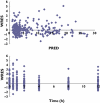Population pharmacokinetics and Bayesian estimator of mycophenolic acid in children with idiopathic nephrotic syndrome
- PMID: 20406220
- PMCID: PMC2848409
- DOI: 10.1111/j.1365-2125.2010.03615.x
Population pharmacokinetics and Bayesian estimator of mycophenolic acid in children with idiopathic nephrotic syndrome
Abstract
Aims: To develop a population pharmacokinetic model for mycophenolic acid (MPA) in children with idiopathic nephrotic syndrome (INS) treated with mycophenolate mofetil (MMF), identify covariates that explain variability and determine the Bayesian estimator of the area under the concentration-time curve over 12 h (AUC(0-12)).
Methods: The pharmacokinetic model of MMF was described from 23 patients aged 7.4 +/- 3.9 years (range 2.9-14.9) using nonlinear mixed-effects modelling (NONMEM) software. A two-compartment model with lag-time and first-order absorption and elimination was developed. The final model was validated using visual predictive check. Bayesian estimator was validated using circular permutation method.
Results: The population pharmacokinetic parameters were apparent oral clearance 9.7 l h(-1), apparent central volume of distribution 22.3 l, apparent peripheral volume of distribution 250 l, inter-compartment clearance 18.8 l h(-1), absorption rate constant 5.16 h(-1), lag time 0.215 h. The covariate analysis identified body weight and serum albumin as individual factors influencing the apparent oral clearance. Accurate Bayesian estimation of AUC(0-12) was obtained using the combination of three MPA concentrations measured just before (T(0)), 1 and 4 h (T(1) and T(4)) after drug intake with a small error of 0.298 microg h(-1) ml(-1) between estimated and reference AUC(0-12).
Conclusions: The population pharmacokinetic model of MPA was developed in children with INS. A three-point (T(0), T(1) and T(4)h) Bayesian estimator of AUC(0-12) was developed and might be used to investigate the relation between MPA pharmacokinetic and pharmacodynamics in children with INS and determine if there is any indication to monitor MPA exposure in order to improve patient outcome based on individual AUC-controlled MMF dosing.
Figures



References
-
- Churg J, Habib R, White RHR. Pathology of nephrotic syndrome in children: a report for the International Study of Kidney Disease in Children. Lancet. 1970;760:1299–302. - PubMed
-
- Cattran DC, Alexopoulos E, Heering P, Hoyer PF, Johnston A, Meyrier A, Ponticelli C, Saito T, Choukroun G, Nachman P, Praga M, Yoshikawa N. Cyclosporin in idiopathic glomerular disease associated with the nephrotic syndrome: workshop recommendations. Kidney Int. 2007;72:1429–47. - PubMed
-
- Hino S, Takemura T, Okada M, Murakami K, Yagi K, Fukushima K, Yoshioka K. Follow-up of children with nephrotic syndrome treated with a long-term moderate dose of cyclosporine. Am J Kidney Dis. 1998;31:932–9. - PubMed
-
- Okada M, Hino S, Takemura T, Fukushima K, Yoshioka K. Cyclosporine therapy in children with steroid-resistant nephrotic syndrome. Clin Exp Nephrol. 1999;3:S34–9.
-
- Moudgil A, Bagga A, Jordan SC. Mycophenolate mofetil therapy in frequently relapsing steroid-dependent and steroid-resistant nephrotic syndrome of childhood: current status and future directions. Pediatr Nephrol. 2005;20:1376–81. - PubMed
Publication types
MeSH terms
Substances
LinkOut - more resources
Full Text Sources

